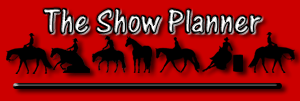 |
|
Show Horse Promotions Mary Murray
|
The Way of Horses
|
Equine Digestion Begins With the Lips and TeethYou out in one end and take it out the other! Do you know what happens to expensive grain and hay during its long journey to become manure? Equine lips have almost a prehensile (adapted to wrap or fold around an object) ability. They can separate oral additives from grain, chose the tender shoots of grass and untie a lead rope. A horse's meal starts at the lips which gather feed and make it available to the teeth. Desirable grass is collected by the lips and presented to the incisors for snipping and moved back with the tongue to the molars for grinding. Loose products (for example - grain and hay) are collected and moved directly back to the molars. Mechanical breakdown of the feed now takes place. The upper premolars and molars (back teeth) are set wider than the lower arcade. This configuration keeps the teeth from meeting squarely when the horse is not chewing. In order to make good contact the jaw must move back and forth. This side to side movement and the natural misalignment of the upper and lower teeth causes the teeth to wear at an angle. Malocclusion, a term used to describe teeth that do not meet properly, occurs. Points (sharp edges), ramps (excessive lower premolar height), hooks (a tooth overhangs the opposing tooth, waves (the arcade of teeth becomes uneven) and other tooth wear patterns develop. An equine dentist or veterinarian can attempt to eliminate tooth wear problems so the horse can chew comfortably. Another unique characteristic to equine teeth is they do not grow - they erupt. Teeth are formed soon after foaling and the entire unused tooth is stored in the dental socket until needed. 4 ½ to 5 inches of tooth lies below the gum line in a young horse. This amount must last the horse his entire lifetime. As the exposed surface wears away new tooth erupts. The equine dentist or veterinarian attempting to correct malocclusions must be careful not to become overzealous when grinding down the exposed surface. An inexperienced operator with a power float can take years off a horse's life expectancy. Once the horse has moved the feed back to the molars he begins to chew. The chewing action stimulates three pairs of salivary glands. A horse will produce five to ten gallons of saliva per day. The production of salvia is very important to the digestion of feed. Salvia contains buffers that protect the stomach from acids, and contains some enzymes that start the breakdown of carbohydrates. Salvia moistens the feed so it is easy to swallow. Horses being fed a complete feed (grain and forage in one product) or a diet consisting of mostly pellets do not get enough chew-time. Horses in a natural environment will graze 18-20 hours per day, producing large quantities of salvia. Horses in confinement are lucky to get four hours of chew-time. Horses that bolt their feed may not chew feed long enough, reducing the amount of salvia produced. Several large rocks placed in the feeder will slow down the concentrate consumption and cause the horse to chew for longer periods of time. This will also decrease the chances of choke caused when feed is not being moistened or broken down before swallowing. Providing adequate amounts of long-stem fiber (grass, hay, hay cubes or chopped hay) will aid the production of salvia. Pelleted products will not achieve the desired result. The product must contain particles at least three-quarters (3/4) of an inch long. Once the feed reaches a slurry consistency the horse swallows and the meal's journey continues. Copyright© Eleanor Richards http://www.thewayofhorses.com
|
|
© 2000 - 2010 Show Horse Promotions The Show Horse Promotions web site is an informational web site, this information is subject to change without notice. Any use of, or actions taken based upon any of the information contained on this web site is done entirely at your own risk. Show Horse Promotions expressly prohibit you from republishing or redistributing this content without first receiving our written consent. By using this site, you agree not to hold us liable for any errors or delays in this content, or for any actions that you take in reliance thereon. This site contains links to other Internet sites. These links are not endorsements by us of any products or services in those sites, and we have not endorsed or approved any information in those sites. |
|
||||||||
